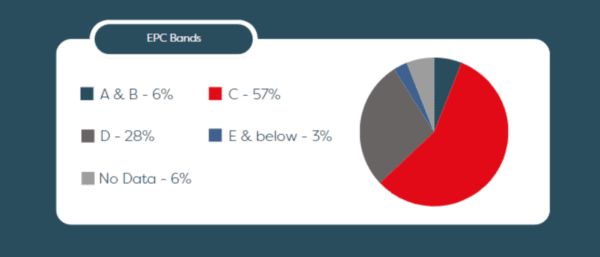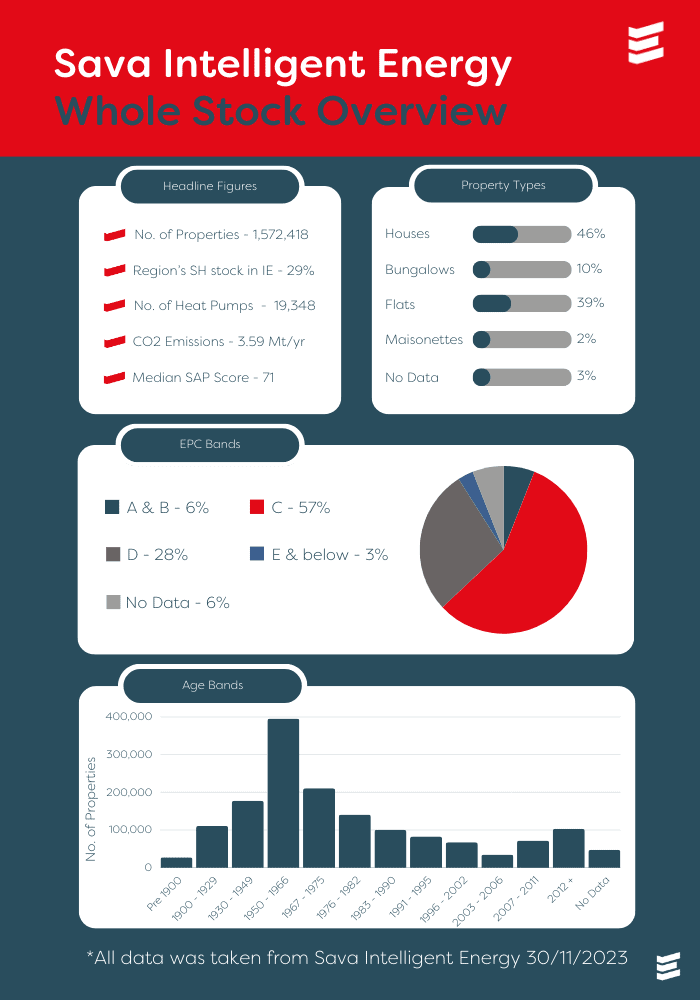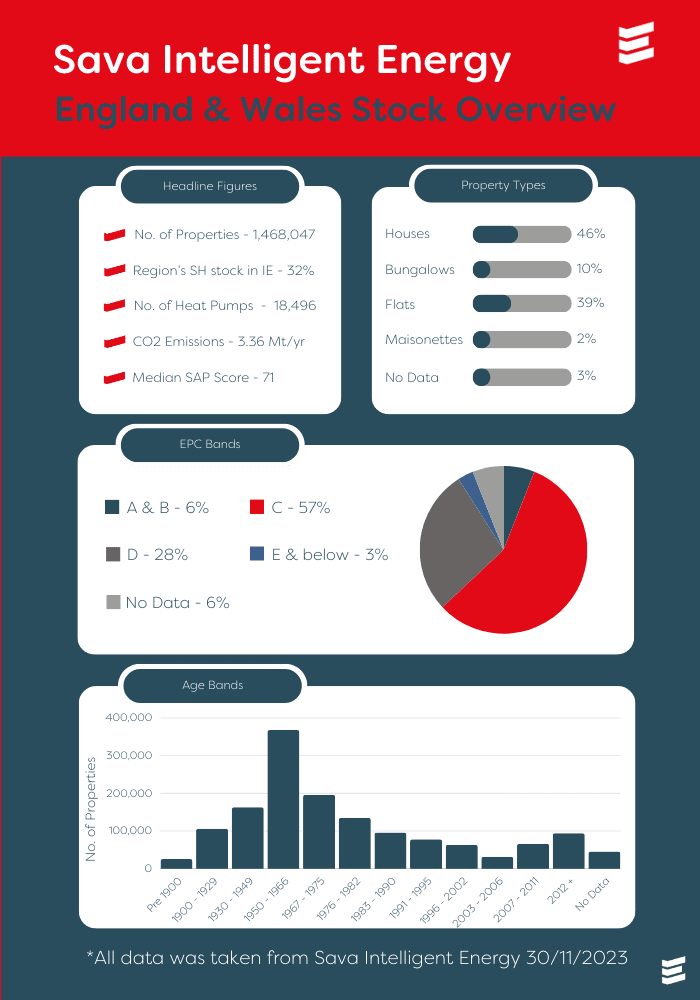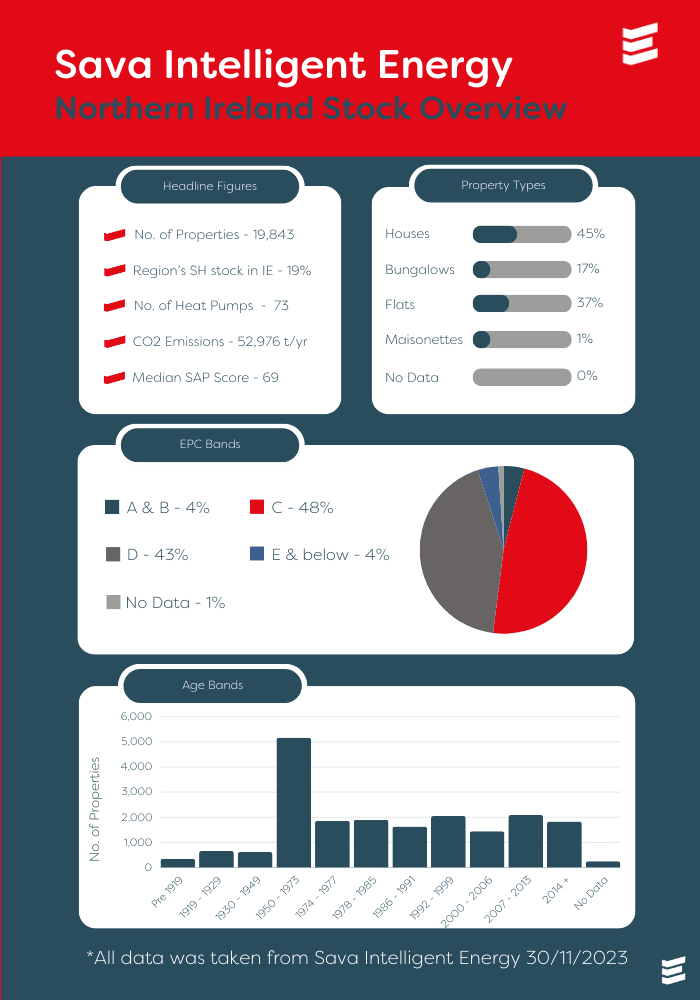Sava Intelligent Energy: Housing Stock Overview 2023.

The UK is committed to net zero carbon emissions by 2050 and for this to happen all sectors will have to massively reduce their emissions.
The Government estimated that in 2022 17% of the UK’s emissions came from the residential sector, evidencing the importance of decarbonising our homes. With approximately 5.35 million of the UK’s 29 million properties being social rented, housing providers have a big role to play in this. When the recent high energy prices and rates of fuel poverty are also considered, the urgency with which energy efficiency improvements need to be delivered is clear.
The challenge for many RSLs looking to achieve this is firstly to gain an understanding of their stock’s energy performance that can be trusted, and secondly to develop a cost-effective retrofit strategy that will deliver energy and emissions savings.
What is Sava Intelligent Energy?
Sava Intelligent Energy (IE) is one of our leading energy modelling software products. It provides landlords with an overview of the energy performance of their entire housing stock, using our powerful RdSAP and SAP calculation engines. IE also supports analysis and improvement planning for reducing energy and carbon, taking data directly from asset management systems.
Using the data input into IE by our 200+ users up until 30/11/2023, unique insights have been made about the housing stock in IE and how it compares to the rest of the sector.
The data has been used to provide an overview of the whole IE housing stock, as well as each of the UK’s four nations. England and Wales are grouped together as one region in IE because this is how they are classified in the latest version of RdSAP (9.94) and therefore will be dealt together in this stock overview.
Whole Stock Overview
There are a total of 1.57 million properties in IE across the UK. The median SAP rating of all the properties is 71 and 30% of properties are EPC Band D or below, meaning they require efficiency improvements to meet the aspirational targets of EPC Band C by 2030 for fuel poor homes and 2035 for all homes. The stock collectively emits 3.59 MtCO2/yr, or the equivalent to 2.28 tCO2/yr per property.
There are 19,348 properties with heat pumps, equivalent to 1.23% of all properties in IE. Comparatively, the MCS (the certification scheme for low-carbon energy technologies in the UK) Data Dashboard, which tracks MCS certified installations, only has 17,936 recorded.
England & Wales Overview
Out of all the properties in IE, 93% or 1.47 million are in England and Wales. Due to this overwhelming majority, the stock from this region performs very similarly to the whole IE stock. Of all the regions, the England and Wales IE stock represents the greatest proportion of the corresponding region’s whole social housing stock at 32%.
The median SAP rating is 71 and 63% of the properties are EPC Band C and above. The stock emits 3.36 MtCO2 per year, an average of 2.29 tCO2/yr per property.
The England and Wales IE stock has the highest density of heat pumps out of all the regions, with 18,469 properties having heat pumps, equivalent to 1.26% of all properties in the region.
Scotland
84,528 of the properties in IE are in Scotland. This represents 15% of the region’s whole social housing stock.
Out of all the regions in IE, the Scotland stock is the most energy efficient with a median SAP rating of 73 and 75% of properties EPC Band C or above. When compared with the energy performance of Scotland’s whole social housing stock, the properties in IE rank better, with only 65% of the sector EPC Band C or above.
As to be expected from the superior energy efficiency of the Scottish IE stock, it also has the lowest average emissions per property at 2.11 tCO2/yr. In addition, 779 properties have heat pumps, which works out at 0.92% of all the properties in the region.
Northern Ireland
The Northern Ireland IE stock is the smallest of all the regions, with 19,843 properties located there. Despite this, the Northern Ireland IE stock represents 19% of the region’s social housing sector, the second highest share of the three regions and 5% greater than Scotland.
The Northern Ireland IE stock is the least energy efficient housing with a median SAP rating of 69 and only 52% of properties EPC Band C or above. The average property in the Northern Ireland IE stock emits 3 tCO2/yr, the highest of all regions.
Only 73 properties have heat pumps, equivalent to 0.37% of the Northern Ireland IE stock.
All of these findings and more can be found in the below infographics. Alternatively, you can download these as a PDF here. If you would like to find out more about Sava Intelligent Energy, please do not hesitate to contact us at technology@sava.co.uk.



